汽车专业英语读译教程翻译UNIT 7 TEXT A
汽车专业英语电子课件Unit 7
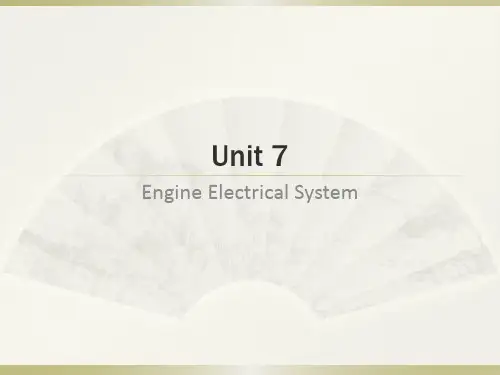
Text A Battery
Charging and Discharging Principle (Fig.7.3) A battery charges and discharges electrical energy through the chemical reaction of the electrolyte. (a) Electrical energy is generated when the sulfuric acid of the electrolyte reacts with lead and turns into water. At this time, the sulfuric acid combines with the pole plates, causing the positive and negative pole plates to turn into lead sulfate. (b) Because sulfuric acid is discharged from the pole plates, the electrolyte turns into sulfuric acid, and the specific gravity of the electrolyte increases. The positive pole plates turn into lead dioxide and the negative pole plates turn into sponge lead.
Text C Charging System
Text A Battery
The starter battery supplies and stores the energy for the electrical systems in a motor vehicle. As it can be recharged, it is also referred to as an accumulator. The composition of a common battery is shown as Fig.7.2. When the engine is running, it stores the used electricity.
汽车专业英语部分翻译
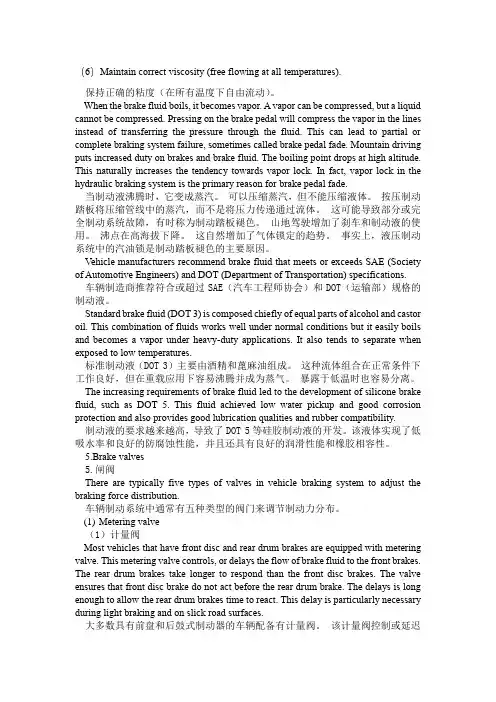
(6)Maintain correct viscosity (free flowing at all temperatures).保持正确的粘度(在所有温度下自由流动)。
When the brake fluid boils, it becomes vapor. A vapor can be compressed, but a liquid cannot be compressed. Pressing on the brake pedal will compress the vapor in the lines instead of transferring the pressure through the fluid. This can lead to partial or complete braking system failure, sometimes called brake pedal fade. Mountain driving puts increased duty on brakes and brake fluid. The boiling point drops at high altitude. This naturally increases the tendency towards vapor lock. In fact, vapor lock in the hydraulic braking system is the primary reason for brake pedal fade.当制动液沸腾时,它变成蒸汽。
可以压缩蒸汽,但不能压缩液体。
按压制动踏板将压缩管线中的蒸汽,而不是将压力传递通过流体。
这可能导致部分或完全制动系统故障,有时称为制动踏板褪色。
山地驾驶增加了刹车和制动液的使用。
沸点在高海拔下降。
这自然增加了气体锁定的趋势。
事实上,液压制动系统中的汽油锁是制动踏板褪色的主要原因。
汽车专业英语全书翻译
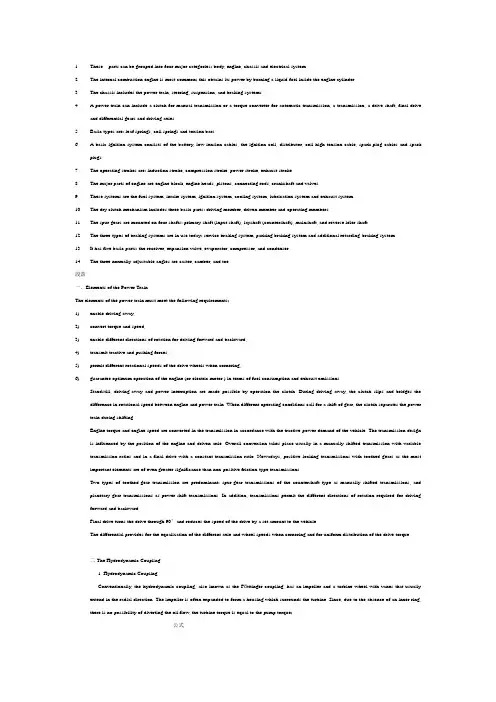
1.These parts can be grouped into four major categories; body, engine, chassis and electrical system.2.The internal combustion engine is most common; this obtains its power by burning a liquid fuel inside the engine cylinder.3.The chassis includes the power train, steering, suspension, and braking systems.4. A power train can include a clutch for manual transmission or a torque converter for automatic transmission, a transmission, a drive shaft, final driveand differential gears and driving axles.5.Basic types are: leaf springs, coil springs and torsion bars.6. A basic ignition system consists of the battery, low-lension cables, the ignition coil, distributor, coil high-tension cable, spark plug cables and sparkplugs.7.The operating strokes are: induction stroke, compression stroke, power stroke, exhaust stroke.8.The major parts of engine are engine block, engine heads, pistons, connecting rods, crankshaft and valves.9.These systems are the fuel system, intake system, ignition system, cooling system, lubrication system and exhaust system.10.The dry clutch mechanism includes three basic parts: driving member, driven member and operating members.11.The spur gears are mounted on four shafts: primary shaft (input shaft), layshaft (countershaft), mainshaft, and reverse idler shaft.12.The three types of braking systems are in use today: service braking system, parking braking system and additional retarding-braking system.13.It has five basic parts: the receiver, expansion valve, evaporator, compressor, and condenser.14.The three normally adjustable angles are caster, camber, and toe.段落一.Elements of the Power TrainThe elements of the power train must meet the following requirements;1)enable driving away,2)convert torque and speed,3)enable different directions of rotation for driving forward and backward,4)transmit tractive and pushing forces,5)permit different rotational speeds of the drive wheels when cornering,6)guarantee optimum operation of the engine (or electric motor ) in terms of fuel consumption and exhaust emissions.Standstill, driving-away and power interruption are made possible by operation the clutch .During driving away, the clutch slips and bridges the difference in rotational speed between engine and power train. When different operating conditions call for a shift of gear, the clutch separates the power train during shifting.Engine torque and engine speed are converted in the transmission in accordance with the tractive-power demand of the vehicle. The transmission design is influenced by the position of the engine and driven axle. Overall conversion takes place usually in a manually shifted transmission with variable transmission ratios and in a final drive with a constant transmission ratio. Nowadays, positive-locking transmissions with toothed gears as the most important elements are of even greater significance than non-positive friction-type transmissions.Two types of toothed-gear transmission are predominant: spur-gear transmissions of the countershaft type as manually shifted transmissions, and planetary-gear transmissions as power-shift transmissions. In addition, transmissions permit the different directions of rotation required for driving forward and backward.Final drive turns the drive through 90°and reduces the speed of the drive by a set amount to the vehicle.The differential provides for the equalization of the different axle and wheel speeds when cornering and for uniform distribution of the drive torque.二.The Hydrodynamic Coupling1. Hydrodynamic CouplingConventionally, the hydrodynamic coupling, also known as the Fötttinger coupling, has an impeller and a turbine wheel with vanes that usually extend in the radial direction. The impeller is often expanded to form a housing which surrounds the turbine. Since, due to the absence of an inner ring, there is no possibility of diverting the oil flow, the turbine torque is equal to the pump torque;公式Therefore 公式The index number depends on the design, the vane angle and the degree of filling of the coupling. The main working area of an hydrodynamic coupling is at v=0.9.2. Hydrodynamic ConverterThe hydrodynamic converter, also known as the Trilok or Fötttinger converter, is capable of operating in two phases: with torque increase in the first phase, and as a hydrodynamic coupling in the second phase. The usual design has three impellers:1) The pump, which is connected to the engine, acts like a centrifugal pump to produce the flow energy of a fluid.2) The turbine, which is connected to the transmission input, converts the flow energy back into mechanical energy.3) The reactor between turbine and pump diverts the flow of the fluid.Thus, the torque output is higher than the pump torque input from the engine. The torque increaseμμ=Mt/Mp is all the higher, the greater the speed difference (slip)between the pump and turbine. Withυ=0, i.e. with the turbine braked to a standstill (stall point, drive-away point), torque conversion reaches its maximum value and falls virtually linearly with rising turbine speed to a torque ratio of 1:1 at the coupling point. Above the coupling point, the reactor, which is supported on the housing by a one-way clutch, runs, torque-free, in the flow. Thus, the converter is now a clutch without torque conversion.For automobiles, the vane geometries are such that, at the drive-away point, the maximum torque increase μA is between 2 and 2.5. The hydraulic efficiencyηhydr=υμis similar in the conversion range to the speed ratioμand reaches values around 97% at high speed.Fluid couplings form the input element of automatic transmissions (in conjunction with planetary-gear trains, clutches, brakes and one-way clutches) and also of manually shifted transmissions in the form converter and clutch unit.三.Constant-mesh TransmissionFig.3-6 illustrates the flow of torque through a typical constant-mesh transmission. This type uses helical or double helical gears which are always in mesh. The mainshaft gear wheels are mounted on bearings and when a gear is required the mainshaft gear is locked to the shaft by a dog clutch.Although the mechanical efficiency is lower the helical gears are quieter and any damage resulting from a bad gear change occurs to the dog teeth instead of the actual gear teeth.元素的力量训练动力传动的要素必须符合下列要求;1)使开车逃走,2)把转矩和速度,3)使不同方向的旋转带动向前和向后,四)推进传送叶轮力量,5)允许不同转速时的驱动轮转弯时,六)保证了优化运行的引擎(或电机)从油耗和尾气排放。
汽车专业英语读译教程 (梁桂航 第3版 ) 习题与答案TEXT B
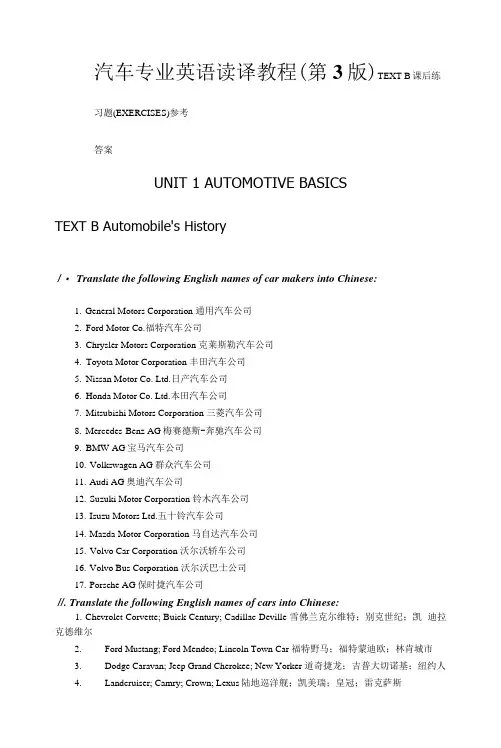
汽车专业英语读译教程(第3版)TEXT B课后练习题(EXERCISES)参考答案UNIT 1 AUTOMOTIVE BASICSTEXT B Automobile's History/ ・ Translate the following English names of car makers into Chinese:1.General Motors Corporation 通用汽车公司2.Ford Motor Co.福特汽车公司3.Chrysler Motors Corporation 克莱斯勒汽车公司4.Toyota Motor Corporation 丰田汽车公司5.Nissan Motor Co. Ltd.日产汽车公司6.Honda Motor Co. Ltd.本田汽车公司7.Mitsubishi Motors Corporation 三菱汽车公司8.Mercedes-Benz AG梅赛德斯-奔驰汽车公司9.BMW AG宝马汽车公司10.Volkswagen AG群众汽车公司11.Audi AG奥迪汽车公司12.Suzuki Motor Corporation 铃木汽车公司13.Isuzu Motors Ltd.五十铃汽车公司14.Mazda Motor Corporation 马自达汽车公司15.Volvo Car Corporation 沃尔沃轿车公司16.Volvo Bus Corporation 沃尔沃巴士公司17.Porsche AG保时捷汽车公司//. Translate the following English names of cars into Chinese:1.Chevrolet Corvette; Buick Century; Cadillac Deville 雪佛兰克尔维特;别克世纪;凯迪拉克德维尔2.Ford Mustang; Ford Mendeo; Lincoln Town Car 福特野马;福特蒙迪欧;林肯城市3.Dodge Caravan; Jeep Grand Cherokee; New Yorker 道奇捷龙;吉普大切诺基;纽约人ndcruiser; Camry; Crown; Lexus陆地巡洋舰;凯美瑞;皇冠;雷克萨斯1.What are the advantages of continuously variable transmission?Because there are no gears to tie a given road speed directly to a given engine speed, the CVT can vary the engine speed as needed to access maximum power as well as maximum fuel efficiency. This allows the CVT to provide quicker acceleration than a conventional automatic or manual transmission while delivering superior fuel economy.2.What are the main components of automated manual transmission?Transmission control ECU, clutch activator, transmission actuator, operators, and sensorsII. Translate the following paragraph into Chinese :The basic technical criteria for continuously variable transmissions are size, weight, transmission-ratio range, transfer efficiency, noise emissions and installation possibilities. With regard to these aspects, mechanical continuously variable transmissions, in the form of chain-driven transmission, have provided the best results so far.评判无级变速器的基本技术标准是尺寸、重量、传动比范围、传动效率、噪声排放和安装可能性。
汽车专业英语全文翻译
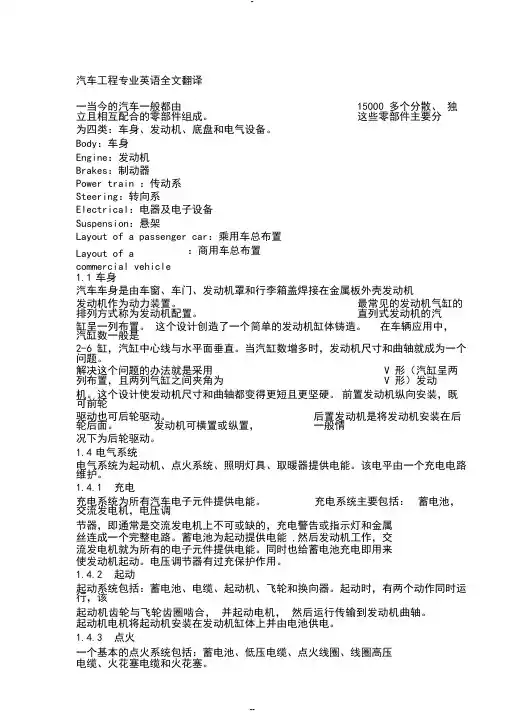
汽车工程专业英语全文翻译一当今的汽车一般都由15000 多个分散、独立且相互配合的零部件组成。
这些零部件主要分为四类:车身、发动机、底盘和电气设备。
Body:车身Engine:发动机Brakes:制动器Power train :传动系Steering:转向系Electrical:电器及电子设备Suspension:悬架Layout of a passenger car:乘用车总布置Layout of a commercial vehicle :商用车总布置1.1 车身汽车车身是由车窗、车门、发动机罩和行李箱盖焊接在金属板外壳发动机发动机作为动力装置。
最常见的发动机气缸的排列方式称为发动机配置。
直列式发动机的汽缸呈一列布置。
这个设计创造了一个简单的发动机缸体铸造。
在车辆应用中,汽缸数一般是2-6 缸,汽缸中心线与水平面垂直。
当汽缸数增多时,发动机尺寸和曲轴就成为一个问题。
解决这个问题的办法就是采用V 形(汽缸呈两列布置,且两列气缸之间夹角为V 形)发动机。
这个设计使发动机尺寸和曲轴都变得更短且更坚硬。
前置发动机纵向安装,既可前轮驱动也可后轮驱动。
后置发动机是将发动机安装在后轮后面。
发动机可横置或纵置,一般情况下为后轮驱动。
1.4 电气系统电气系统为起动机、点火系统、照明灯具、取暖器提供电能。
该电平由一个充电电路维护。
1.4.1 充电充电系统为所有汽车电子元件提供电能。
充电系统主要包括:蓄电池,交流发电机,电压调节器,即通常是交流发电机上不可或缺的,充电警告或指示灯和金属丝连成一个完整电路。
蓄电池为起动提供电能 ,然后发动机工作,交流发电机就为所有的电子元件提供电能。
同时也给蓄电池充电即用来使发动机起动。
电压调节器有过充保护作用。
1.4.2 起动起动系统包括:蓄电池、电缆、起动机、飞轮和换向器。
起动时,有两个动作同时运行,该起动机齿轮与飞轮齿圈啮合,并起动电机,然后运行传输到发动机曲轴。
起动机电机将起动机安装在发动机缸体上并由电池供电。
汽车专业英语翻译
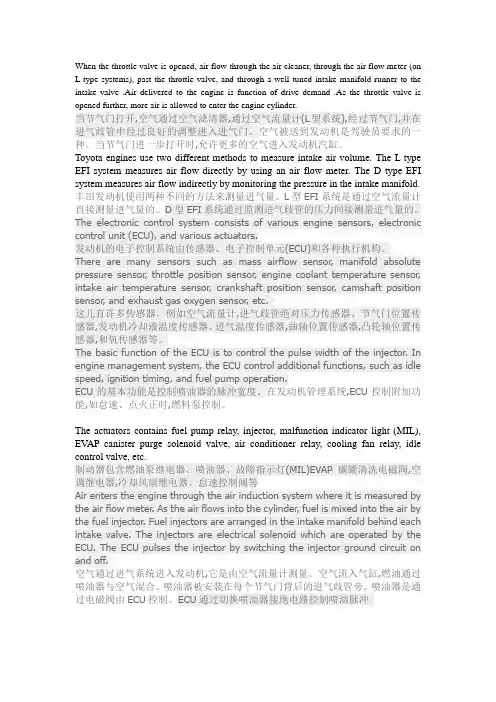
When the throttle valve is opened, air flow through the air cleaner, through the air flow meter (on L type systems), past the throttle valve, and through a well tuned intake manifold runner to the intake valve .Air delivered to the engine is function of drive demand .As the throttle valve is opened further, more air is allowed to enter the engine cylinder.当节气门打开,空气通过空气滤清器,通过空气流量计(L型系统),经过节气门,并在进气歧管中经过良好的调整进入进气门。
空气被送到发动机是驾驶员要求的一种。
当节气门进一步打开时,允许更多的空气进入发动机汽缸。
Toyota engines use two different methods to measure intake air volume. The L type EFI system measures air flow directly by using an air flow meter. The D type EFI system measures air flow indirectly by monitoring the pressure in the intake manifold. 丰田发动机使用两种不同的方法来测量进气量。
L型EFI系统是通过空气流量计直接测量进气量的。
D型EFI系统通过监测进气歧管的压力间接测量进气量的。
The electronic control system consists of various engine sensors, electronic control unit (ECU), and various actuators.发动机的电子控制系统由传感器、电子控制单元(ECU)和各种执行机构。
汽车专业英语单词和翻译重点
1.an understanding of how the systems work help you understand how the automobile works .了解各系统如何工作有助于了解汽车是如何工作的。
2.these support the vehicle and cushion it from road bumps for better ride and handling.它们支撑着车身,并缓解由于路面不平引起的颠簸,以获得更好的乘坐舒适型和操作稳定性。
3.The purpose of an automobile engine is to supply the power needed to move the vehicle.汽车发动机的功用是提供汽车行驶所需的动力4.The internal combustion engine is a device used to convert the chemical energy of thefuel into heat energy .and then convert this heat energy into usable mechanical energy .内燃机是一种将燃料的化学能转化为热能,再把热能转化为可利用的机械能的装置。
5.The amount of air/fuel mixture allowed to enter the cylinder determines the power andspeed developed by the engine .进入汽缸中的可燃混合气体的数量,决定了该发动机的功率和转速。
6.Reducing friction to minimize wear and loss of power is the primary job a lubricationsystem must perform.减少摩擦,降低磨损和动力损失是润滑系统必须完成的主要工作。
汽车专业英语翻译
汽车专业英语翻译Today's average car contains more than 15,000 separate, individual parts that must work together. These parts can grouped into four major categories: engine, body, chassis and electrical equipment.现代汽车有超过15000个零件组成,分成几个必须在一起工作的功能部分。
主要包括4个功能部分:引擎,车身,底盘和电控。
The engine acts as the power unit. The internal combustion engine is most common: this obtains its power by burning a liquid fuel inside the engine cylinder. There are two types of engine :gasoline(also called a spark-ignition engine) and diesel(also called a compression-ignition engine).Both engines are called heat engines; the burning fuel generates heat which causes the gas inside the cylinder to increase its pressure and supply power to rotate a shaft connected to the transmission.引擎为汽车提供能源。
一般是内燃机:通过在引擎缸内燃烧液体燃料获得能量。
引擎有两种:汽油机和柴油机。
两种引擎都叫热机。
汽车专业英语翻译(最新整理)
About car engineOf all automobile components,an automobile engie is the most complicated assembly with dominant effects on the function of an autombile.So, the engine is generally called the"heat"of an automobile.在汽车的所有部件中,汽车发动机是最复杂的组件,其对整车性能有着决定性的作用。
因而发动机往往被称作发动机的“心脏”。
There are actually various types of engines such as electric motors,stream engines,andinternal combustion engines.The internal combustion engines seem to have almost complete dominance of the automotive field.The internal combustion engine,as its name indicates,burns fuel within the cylinders and converts the expanding force of the combustion into rotary force used to propel the vehicle.事实上,按动力来源分发动机有很多种,如电动机、蒸汽机、外燃机等。
然而内燃机似乎在发动机领域有着绝对的统治地位。
就像其字面意思一样,内燃机的染料在气缸内燃烧,通过将燃烧产生气体的膨胀力转换成转动力来驱动发动机前进。
Engine is the power source of the automobile.Power is produced by the linear motion of a piston in a cylinder.However,this linear motion must be changed into rotary motion to turn the wheels of cars or trucks.The puston attached to the top of a connecting rod by a pin,called a piston pin or wrist pin.The bottom of the connecting rod is attached to the crankshaft.The connecting rod transmits the up-and-down motion of the piston to the crankshaft,which changes it into rotary motion.The connecting rod is mounted on the crankshaft with large bearings called rod bearing.Similar bearings, called main bearings,are used to mount the crankshaft in the block.发动机是整部车的动力来源。
电子课件-《汽车专业英语(第二版)》-B24-1273 Unit 7
Fig 7.1 Exhaust AnalyzerPart 1 Text
Multifunction automotive scanner can not only gather and analyze the information on a running car, search for the source of the problems, but also be used as an oscilloscope . At the same time all results are displayed on the screen. If it is connected with a computer, its performance can get better.
An automotive stethoscope , or soundscope, aids in locating the source of engine knocks and noises by amplifying the sound waves. The value of the sounddetecting is to help the technician distinguish the difference between normal and abnormal sounds and to find the location and cause of the latter.
Fig 7.2
Digital Battery Analyzer
True or false?
• (1)A technician can do his work without efficient equipment.( )
• (2)Soundscope cannot find the source of the problems by checking automobile. ( )
- 1、下载文档前请自行甄别文档内容的完整性,平台不提供额外的编辑、内容补充、找答案等附加服务。
- 2、"仅部分预览"的文档,不可在线预览部分如存在完整性等问题,可反馈申请退款(可完整预览的文档不适用该条件!)。
- 3、如文档侵犯您的权益,请联系客服反馈,我们会尽快为您处理(人工客服工作时间:9:00-18:30)。
第7单元排放控制系统课文A 排放控制系统概述为了减小不完全燃烧和蒸发气体对大气的污染,并保持良好的运行性能和燃油经济性,所有的汽车上都采用了多种排放控制系统。
这些系统包括强制式曲轴箱通风(PCV)系统、蒸发排放控制(EV AP)系统、废气再循环(EGR)系统、空气喷射(AIR)系统和三元催化转化器(TWC)系统。
1.PCV系统PCV系统的作用是收集曲轴箱产生的蒸汽和气缸窜气,并将这些气体引入到进气系统,以便在燃烧期间将其烧掉。
这些蒸汽稀释了混合气,因此必须对它们进行精心的控制和计量,以便不影响发动机的性能。
这就是PCV阀的任务。
怠速时,空气燃油混合气非常关键,只允许一点点蒸汽进入到进气系统。
高速时,混合气得浓度就不那么重要了,并且发动机气缸压力也升高,因而允许有更多的蒸汽进入进气系统。
当PCV阀或PCV系统赌塞时,蒸汽就会倒流回到空气滤清器,甚至更糟的是,过大的压力会破坏密封件,导致发动机润滑油的泄漏。
如果使用了不正确的PCV阀,或者PCV系统存在漏气现象,发动机将会怠速不稳,甚至出现将发动机润滑油从发动机内吸出来的现象。
2.EGR系统废气再循环(EGR)系统能降低燃烧过程中所产生的氮氧化合物。
EGR系统使用数量可控的废气来稀释空气-燃油混合气。
由于废气不会燃烧,所以EGR将降低燃烧温度。
在燃烧温度降低的情况下,空气中只有极少的氮与氧结合,而形成氮氧化合物(NO X)。
大部分氮只是随废气而排出气缸。
为了获得良好的运行性能,最好让EGR阀的开度(以及废气流量)与节气门开度呈正比例。
为了改善运行性能,在发动机低温起动、怠速以及节气门全开时,要停止EGR。
由于在不同的发动机上NO X控制要求不同,因此就有使用各种控制装置来提供这些功能的若干不同的EGR系统。
1)EGR阀大多数这样的系统都采用了真空操纵的EGR阀,来调节进入进气歧管的废气流量(图7-1和图7-2)。
进气歧管下面的交叉排气通道将废气通道EGR阀(有些直列式发动机通过一根外部气管将废气通到EGR阀)。
EGR阀一般安装化油器下面的一根板上,或者直接安装在进气歧管上。
EGR阀是一个真空操纵的流量控制阀。
借助膜片处的控制真空打开EGR阀,就能让废气流过该阀而进入进气歧管。
在这里,废气与空气-燃油混合气混合,稀释了混合气,尽管仍能完全燃烧,但燃烧室温度却降低了。
为了确保EGR系统该工作的时候能工作,采用了许多不同的控制装置。
理想的情况是,当发动机达到工作温度时,以及发动机在除了怠速和大节气门开度之外的工况下工作时,EGR系统应该正常工作。
在今天的汽车上所能见到的各种EGR控制装置有:温控真空开关(TVS)、喉管真空放大器(VV A)、背压传感器、EGR真空调节器(EVR)、压力反馈EGR (PFE)传感器和压力传感器(EPT)。
EGR阀有各种设计。
正背压EGR阀在膜片的中央部位有一个通气阀。
一个小弹簧保持该通气阀开启,废气的通道从锥形阀通过阀杆到达放气阀。
当发动机运转时,废气压力加给放气阀。
发动机在低速时,废气压力不足以打开放气阀,发保持关闭。
随着发动机转速和车速的增加,废气压力也会增加。
达到预定的节气门开度时,废气压力将EGR阀通气孔关闭。
当控制真空加给膜片时,膜片和阀就被向上提升,因而阀开启。
如果在发动机不运转的情况下,来自外部真空源的真空就被加到正背压EGR阀上,由于真空通过通气孔而放掉,因此阀将不会打开。
在负背压EGR上,常闭的通气孔位于膜片的中心。
废气的通道从锥形阀的下端,经过阀杆到达通气阀。
当发动机低速运转时,排气系统中就存在高压脉冲。
然而,在这些高压脉之间存在着低压脉冲。
随着发动机转速的增加,在给定的时间内,气缸点火的次数会增加,因而排气系统中各个高压脉冲会靠得很近。
在发动机和车速较低时,排气系统中的负脉冲使通气阀保持开启。
当发动机转速和车速增加到预定值时,排气负压脉冲就会下降,通气阀关闭。
在这种情况下,EGR阀开启。
当在发动机不运转的情况下,将来自外真空源的真空加给负背压EGR阀时,通气孔关闭,真空应该将EGR阀打开。
一个数字式EGR阀内含有多达三个由PCM直接操纵的电磁阀。
每个电磁阀都含有一个可动柱塞,柱塞的锥形端与一个节流孔贴合。
当给任何一个电磁阀通电时,其柱塞就会升起,废弃就会通过节流孔进入进气歧管。
电磁阀和节流孔具有不同的尺寸。
PCM可以操纵其中一个、两个或者全部三个电磁阀动作,从而提供所需要的废气循环量,获得最佳的NO X 控制效果。
EGR阀内含有一个EGR阀位置即EGR阀升程传感器,该传感器是一个线性电位计。
该传感器的信号电压在1V(EGR阀关闭时)到4.5V(EGR阀全开时)之间变化。
为了用脉冲宽度调节原理对EGR阀柱塞和EGR流量进行精确控制,PCM给EGR电磁阀线圈发送通/断脉冲信号。
EGR阀位置(EVP)传感器为PCM提供一个反馈信号,告诉PCM EGR阀的指令位置是否达到。
2)内部废气再循环EGR降低了部分负荷时发动机废气中的氮氧化合物(一氧化氮NO和少量的二氧化氮NO2,合称为氮氧化合物NO X)。
内部废气再循环系统的目的是在没有采用发动机外部管路的情况下,来控制废气的再循环。
在传统的增压箱节流发动机上,在部分节气门开度时,进气道与排气道之间存在一个压力差。
对四冲程发动机,排气行程接近终了时,进气门开启,后面接着一个进气门和排气门同时开启的时期。
在这个气门重叠期内,进气道的低压促使燃烧室内的残余废气倒流入进气道。
结果,燃烧室内的压力下降又促使排气道内的废气倒流回燃烧室。
这些残余废气稀释了进入的空气-燃油混合气。
对新鲜进气的稀释降低了峰值燃烧温度和压力,因而降低了废气中的NO X含量。
过度的稀释会导致不完全燃烧或不稳定燃烧,从而引起了碳氢化合物(HC)的增加。
稀释的最佳程度随着发动机的转速和负荷的变化而变化。
按照常规,利用一种外部废气再循环系统就能获得最佳运行状况所需要的稀释要求。
这种外部废气再循环系统借助于外部管路和控制阀,使数量得到计量的废气进行再循环。
3.蒸发排放控制系统汽油易挥发。
过去,这些蒸发的排放物被放到大气中。
来自汽车的全部HC排放物中有20%来自汽油箱。
1970年,限制汽油箱排放物排放到大气中的排放法规获得通过。
为了消除这个污染源,研制了蒸发排放控制系统。
该系统的作用是收集和保存来自汽油箱和化油器的蒸发排放物。
活性炭罐用来收集燃油蒸汽。
燃油蒸汽吸附在活性炭上,一直到发动机起动时,在发动机真空的作用下,这些蒸汽才被吸入发动机,与空气-燃油混合气一起燃烧掉。
使用该系统要求使用密封的汽油箱盖。
这个汽油箱盖对系统工作如此重要,以至于现在许多州都将汽油箱盖的监测纳入州排放检测计划中。
1970年前的小汽车通过一个通气式汽油箱盖,将燃油蒸汽放到大气中。
今天,采用了密封式汽油箱盖,并采用了改进设计的汽油箱。
汽油箱内必须有汽油蒸汽聚集的空间,以便能将这些蒸汽通往活性炭罐。
一只清污阀用来控制进入发动机的蒸汽流量。
此清污阀受发动机真空的控制。
该系统的一个常见故障就是清污阀损坏和发动机的真空直接将燃油吸进进气系统。
这将加浓混合气并使火花塞被脏污。
大多数活性炭罐都有一个滤网,应将其定期更换。
当燃油经济性变差时,应该对该系统进行检查。
在某些发动机上,动力控制模块(PCM)允许在某些工况下,进气歧管真空将汽油蒸汽吸入燃烧室。
所有这些发动机都采用占空比清污控制系统。
PCM通过操纵占空比EV AP 清污电磁阀来控制蒸汽流量(图7-3)。
4.空气喷射系统由于没有内燃机效率能够达到100%,所以排气中总是存在某些未燃燃料,这就增加了碳氢化合物排放。
为了消除这个排放源,研制了空气喷射系统。
燃烧需要有燃料、氧和热。
三者缺一,燃烧就无法进行。
在排气歧管内,有足够的热量来支持燃烧。
如果引入一些氧,那么任何未燃的燃料都会燃烧。
这种燃烧不会产生动力,但却会使过多的碳氢化合物排放得到降低。
与在燃烧室里的情况不同,这种燃烧是不可控制的,因此,如果废气中的燃油含量过多的话,就会出现爆炸,并发出爆裂声。
有时,在正常情况下(如减速),肺气肿的燃油含量也过高。
在这些情况下,我们会要求关闭空气喷射系统。
这是通过分流阀来实现的。
使用分流阀,而不是关闭空气泵,即可使空气不流向排气歧管,而转移到别处。
由于所有这些都是在燃烧过程完成之后进行的,所以这是一种对发动机性能没有影响的排放控制。
新型的空气喷射系统采用了ECM控制(图7-4)。
当发动机在低温时,PCM就会给控制电磁阀通电。
这就使空气流到空气转换阀。
空气转换阀通电,从而将空气引入到排气道。
发动机升温后,即在闭环模式,PCM就会给控制电磁阀断电,从而使空气流到催化转化器的两个催化床之间。
这就给氧化催化剂提供了额外的氧,从而降低了HC和CO排放,同时还使第一个催化床保持较低的氧量水平。
这就使还原催化剂能更有效地降低NO X排放值。
5.催化转化器汽车排放物的控制有三种方法。
一是促成更加完全的燃烧,使燃烧的有害副产物减少;二是使过多的碳氢化合物返回到发动机进行燃烧;三是提供一个可供氧化或进行燃烧的额外场所。
这种额外的场所就使催化转化器。
催化转化器的外观像一只消声器。
它位于排气系统中消声器的前面。
在催化转化器内,有用铂或钯制成的很多小球或一个蜂窝结构。
铂和钯用作催化剂(催化剂是一种用于加速化学反应过程的物质)。
当废气中的碳氢化合物和一氧化碳从催化剂上经过时,就会被氧化而转变成二氧化碳和水。
随着催化转化器工作,就会产生热。
废气中有害成分越多,催化转化器工作就越艰难,产生的热量就越多。
在某些情况下,由于过热,可能会看到转化器发光。
如果转化器难以净化污浊的废气,它将自我损毁。
含铅汽油也会在铂和钯催化剂层上形成一个涂层,而导致转化器失效。
